Start Army Aviator Training the Old-Fashioned Way
John Bolton
I prayed that I might not be posted to a training squadron.
-- C.S. Lewis
The Army Aviation Center of Excellence (USAACE) at Ft. Rucker has changed the aircraft used for Initial Entry Rotary Wing (IERW) training from the TH-67 (Bell 206) to the LUH-72 Lakota. Though the LUH was not designed as a trainer, it replaced the venerable TH-67, which had been Army Aviation’s primary trainer since the 1980s.[1] According to the 110th Aviation Brigade, the LUH will improve training because, “A lot of the instrumentation crosses over and systems management [in the LUH] is much better this way, as is habit transfer when they go to war-fighting helicopters.”[2] While the LUH does resemble advanced Army aircraft in terms of mechanical systems and avionics, this may not necessarily result in positive habit transfer. Airmanship does not rest solely on instrumentation or procedures. This is a trend within the American military; we often mistake technology for understanding. In doing so, we forget that thorough individual training is the basis for developing unit competence.
This article argues that while the LUH is a good place for Army Aviators to begin rotary-wing flight training, the proper place for new aviators to start flight training in is a simple, fixed-wing trainer like the C-172 or Diamond DA-20. In addition to saving money, running Army Aviators through a fixed-wing training program would reap training dividends in several ways. First, it would create a reservoir of knowledge and talent regarding fixed-wing aircraft. Second, it would make junior aviators comfortable with the handling characteristics of multiple aircraft, enhancing their basic airmanship. Most importantly, learning basic airmanship, flight procedures, and radio operations under less demanding conditions would enhance the rotary-wing specific training aviators receive. If a junior aviator is already comfortable with traffic avoidance, understanding radio procedures, and basic airmanship, he or she is more primed for advanced instruction. This is the training methodology adopted by the other services, commercial aviation, and advocated by general aviation experts like Rod Machado.
While the goal of FSXXI is producing helicopter pilots, the methodology of starting in a complex helicopter is questionable. Army Aviators should start in fixed-wing trainer before moving to helicopter training. In this paradigm, the LUH works well. While moving from fixed-wing to rotary-wing aircraft would require a transition, the challenge is exaggerated; airmanship is not platform-specific, more so if a pilot has a solid grasp of the basics. Concentrating on flying fundamentals—stick and rudder skills—creates aviators better prepared to operate complex aircraft and, to borrow a phrase from the Army Operating Concept, fight and win in a complex world. Focusing on skills, not aircraft, instrumentation, or technology, enabled WWII-era Army Air Corps pilots to change aircraft with little more than a class on starting the engine.[3]
Flight Training in Other Services
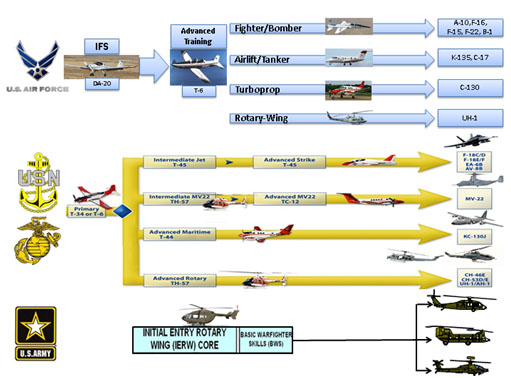
Comparison of Military Flight Training[4]
The Army is the only military service that does not begin pilot training in a basic trainer. Naval Aviators begin training in the T-6 Texan for nearly a year before moving on to more advanced aircraft in accordance with their track (Strike, Transport, Helo, etc.). They then fly at least one more training aircraft before their designated aircraft and earning their wings.
The Air Force goes a step further, screening candidates before military flight training. USAF pilot candidates conduct a 40-day program called Introductory Flight Screening (IFS). During IFS, civilian instructors conduct basic flight training using the Diamond DA-20, a two-seat light aircraft. This program screens upwards of 1,700 candidates annually.[5] Only after completing 25 flight hours and a check ride can prospective pilots on to more advanced aircraft.
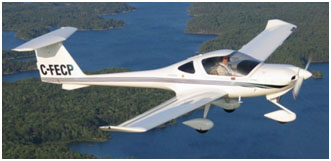
The Air Force begins flight training using the two-seat Diamond DA-20.[6]
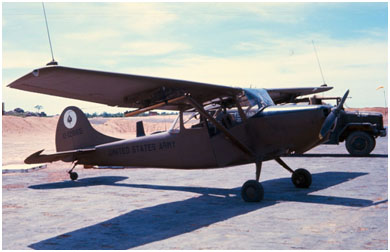
The original Army Aviation trainer, an L-19, was first used in 1950s.[7] It was a modified Cessna 170.
The Navy and Air Force flight training programs follow historical paradigms. During WWII “the American system of training held that a fledging pilot was incapable of handling high-performance planes during the early stages of his career, so he moved carefully and systematically from simpler to more demanding aircraft and maneuvers."[8] Army Air Forces pilots started in biplanes before progressing to primary training in monoplanes, then advanced training in the P-40 and AT-11. Only then did pilots progress to final training in combat aircraft.[9] In fact, even amid war-time pressure to produce pilots quickly, efforts to incorporate advanced aircraft into training earlier were canceled because rushed training made worse pilots.[10] The Army continued using fixed-wing trainers into the 1960s. It was only after the 1968 Johnson-McConnell Agreement gave all fixed-wing aircraft to the Air Force, while giving the Army free reign over helicopters, that we adopted helicopter-only training.[11]
Given the prevalence of joint operations today, especially with regard to Unmanned Aerial Systems (UAS), Army Aviation should no longer be bound by the past. If Air Force jets, host-nation civilian traffic, and Army UAS can share airspace, there is no reason not to consider adopting a fixed-wing trainer.

Generalized Army Air Forces WWII Training Pipeline.
We tend to think of military strength in terms of wonder weapons that are in reality mechanistic solutions… Growing operating costs have overwhelmed the savings accrued from the significant long-term reductions in personnel and force structure.
-- Chuck Spinney, Defense Analyst
Benefits of Simple Trainers
The rationale for starting flight training in simple fixed-wing aircraft has little to do with the composition of aircraft fleets and everything to do with the quality of training. There are three benefits. First, putting prospective aviators into simpler aircraft allows instructors to determine flaws in airmanship—or suitability for further training—much earlier and much cheaper. Second, this methodology greatly reduces the cost of future flight training, particularly if a candidate does not meet criteria early. Third, learning the basics thoroughly, without the complication or distraction of advanced avionics and multiple engines, reduces stress when junior aviators transition to complex aircraft. In other words, pilots who are well-trained in basic aircraft perform better when upgrading.[12]
Cost is the most obvious benefit when comparing fixed-wing trainers to helicopters. Fixed-wing trainers measure hourly rates in hundreds, not thousands of dollars. Unit cost is also substantially lower. Fixed-wing trainer avionics are comparable to modern aircraft; in fact, the Cirrus SR-22 and Cessna C172S often have digital displays, coupled autopilots, and are fully IFR.

However, simple aircraft have other advantages. Their systems and airframes are rugged. Complexity results in down time, no matter how well aircraft are maintained. During the 1960s, NASA engineers used to say that even with 99.99% reliability, the Apollo spacecraft would still have over 2,000 faults. In a training environment with multiple iterations of students every day, every aircraft is critical.
Training aircraft are forgiving to the new student, shallowing the learning curve. Emergency procedures like simulated engine failures result in 500fpm descents instead of 1,000fpm+. Students trained in stalls and slow flight in fixed-wing aircraft will understand the aerodynamic processes inherent in rotary-wing flight in ways that helicopter-only students will not. Trainers teach the basics well because they are designed to do so. It is axiomatic that aircraft designed for specific purposes are better suited to that task than multi-role aircraft.[13]
Given the importance of training and the amount of money spent on it, the aircraft used should be well suited. As the best means of training pilots is actual flight hours, we must aim to give trainees the maximum amount. Fixed-wing trainers accomplish this goal.
The only thing resembling a certainty about future military contingencies is that we are likely to face threats we do not now foresee…the common-sense approach [is to] develop forces and strategies that give us the greatest possible capacity to adapt to whatever the future brings.
- - James Fallows
Training at Ft. Rucker
From 2005-2007, USAACE adopted a new flight training regime. Flight School 21 (FSXXI) increased cost between $60k and $200k per aviator but gave each graduate significantly more time in their primary aircraft.[14] The intent of FSXXI is to produce Readiness Level (RL) 2 equivalent aviators, by having Ft. Rucker, rather than operational units, bear additional training expense. Qualitatively, FSXXI meets this goal.[15]

The LUH-72 is a capable aircraft, but at $5 million each and costs over and $2,500 per hour, it is a better option for advanced, not primary, training.[16]
Now Ft. Rucker has adopted the LUH as its training platform, a move that gives junior aviators a taste of the multiengine, advanced airframes they will eventually fly. Of course, training in more advanced (more expensive) aircraft comes with limitations. Most noticeably for helicopter pilots is the lack of touchdown autorotations in the LUH.[17] The LUH also comes with financial cost; no other service or civilian program teaches students to hover at $3,000 per hour. Additionally, Army students will now miss perhaps the most important element of flight training: the student solo. Given the cost of the LUH and the limited helicopter experience of students, not allowing solos arguably makes sense. However, solos are critical for instilling pilot responsibility and proficiency. Taking away the instructor in a structured environment not only helps students realize their own skills and potential, it helps them strive for the next level of aviator proficiency. The intrinsic value of solo flight is acknowledged in civilian flight training, where pre-check ride private pilots must have at least 10 solo flight hours.[18] Giving junior aviators the keys to a safe, reliable, and cheap trainer is an easy way to incorporate solos into Army flight training.
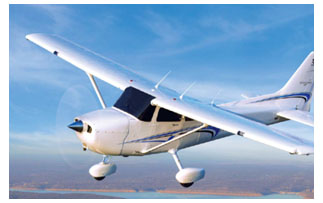
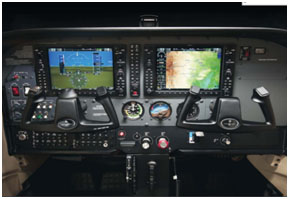
The Cessna 172 is a simple, reliable, American-made primary trainer that utilizes a glass cockpit for a fraction of the cost of helicopters.[19]
Various civilian aircraft are used throughout the world as primary trainers. Aircraft like the Cessna 172, Cirrus SR-22, Diamond DA-20, and Piper Comanche are simple, reliable, and inexpensive. Many trainers can also easily hold four people. The LUH-72, on the other hand, is primarily a utility helicopter, not a trainer.[20] This creates several problems. The aircraft is overpriced and overly complicated for initial flight training. Two engines, advanced avionics, and intricate flight control systems intimidate a first-time user, even with experience in a simulator. However, the LUH is still a good choice for primary rotary-wing training because it is relatively cheap and its avionics and aircraft systems make it a logical intermediary between a simple, fixed-wing trainer and the AH-64D/E, UH-60M, or CH-47F.

Focus on the Basics
Pilots who learn to fly from the get-go in ‘technically advanced’ aircraft rarely understand or develop the art of airmanship and often aren’t aware when they get too close to the edge.[21]
- - Martha Lunken, FAA Inspector and Flying Magazine contributor
Technology has a place in training, but we should be careful of its limitations. A case study from the Gulf War illustrates the fiction of overwhelming technology making all the difference. Using data from engagements between VII Corps and the Republican Guard, most of which survived bombing more or less intact, Stephen Biddle showed that the causative factor in most engagements was the individual and collective skill of American units.[22] In short, training, not FLIR, GPS, or communication technology, carried the day; technology only served to exacerbate the difference competence and collective proficiency between American and Iraqi units.
Our fascination with technology often results in “expensive and delicate high-tech white elephants” that only perform better in tests unrepresentative of combat environments.[23] For a contemporary example, we only need to look at the F-35’s development. Unlike this multi-role monster, simple trainers like the Cessna 172 are “pure expressions of function, “designed to perform a limited set of tasks very well.[24]
Technology can aid training, but it is no substitute for the complex neurological functions required to simply observe and control an aircraft’s attitude. Students may benefit from including multiple engines and advanced avionics. However, during the initial stages of flight training students should concentrate on the fundamentals of flight such as how altitude, weight, and airspeed relate to performance, and, critically, the relationship between attitude and power. They must also learn cross-country navigation through both digital and analog methods. Lastly, letting students make navigational decisions in an aircraft without full-color moving maps will help them operate in a dynamic environment, where information is often unclear or conflicting.
The best platform to do this is simple fixed-wing aircraft. The principles of control and airmanship apply to helicopters as well as fixed-wing aircraft. Teaching airmanship, as opposed to aircraft specific procedures and methods, develops competent aviators. This approach will pay dividends when more well-rounded pilots enter advanced aircraft. Having learned to fly airplanes after helicopters and then teaching other Army Aviators the same, I can confidently say that learning airplanes makes for better helicopter pilots. Properly understood airmanship skills are transferable.
Focusing on the basics under simpler, less demanding conditions would allow for more focus on model-specific characteristics when aviators move to their advanced aircraft. With a better understanding of the basics of flight and operations, aviators could advance more quickly, potentially allowing instructors to include more scenario based training (SBT).[25] Using SBTs is a proven technique commonly used during commercial instruction; more importantly, incorporating SBT would facilitate the FSXXI goal of producing RL-2 equivalent aviators.
Moreover, this approach would aid the long-term goal of FSXXI by creating aviators better prepared for training at operational units, not only RL progression but to acts a pilots in command as well. Since the Army does not create pilots in command during training, as the other services do, we would be wise to utilize student solos during primary training as a means to teach planning, responsibility, and decision-making. Instilling these tenets early will help both immediately during initial training at Ft. Rucker and when new aviators arrive at their units.
Though giving Aviators more time in their principal aircraft was a goal of the FSXXI remodel, we should consider their capability when undergoing this advanced training.[26] An Aviator who is not ready for the major step from simple aircraft will waste aircraft and instructor time in a UH-60M or AH-64D/E to the tune of thousands of dollars per hour. We should seek to maximize the not just the number of hours aviator spend in advanced training but the quality of those hours as well.
Aviation can longer rely on deployments to produce competent pilots in command. Though the tempo for aviation units is still high, opportunities for a junior aviators to gain 500 hours in a summer are likely gone for the foreseeable future. Consequently, Ft. Rucker must strive to produce the best pilots it can. Training prepares military aviators to fly and fight; it also initiates them into a warrior culture. Training should be an all-pervasive phenomenon, a constant that occurs during war and peace.[27] If we understand this premise, it follows that the basics are crucial. The initial hours spent in an aircraft teach the “the foundation upon which future flight training can build.”[28] Making the best use of these hours—at the right price—will improve a generation of Army Aviators.
Note on Methodology: Aircraft costs are notoriously difficult to pinpoint. This article utilized the FY16 DoD Fixed Wing and Helicopter Reimbursement Rates for hourly costs. The Cessna 172 rate was derived from an average of rental rates plus 50%. Aircraft unit costs are from the average of FY 10-16 DoD budget requests, civilian websites, or historical data. All costs are displayed in 2016 dollars, adjusted by the CPI.
End Notes
[1] Airbus Helicopters, “EC-145,” retrieved July 2, 2016 https://www.airbushelicopters.com/website/en/ref/EC145_31.html;
[2] Mark Huber, “Flight Training Begins for First Class of Lakota Pilots,” Aviation International News,” January 28, 2016, accessed July 2, 2016, http://www.ainonline.com/aviation-news/defense/2016-01-28/flight-training-begins-first-class-lakota-pilots.
[3] Phillip S. Meilinger, Hoyt S. Vandenberg: the Life of a General (Bloomington, IN: Indiana University, 1989), 53.
[4] Compiled by the author from multiple sources, primarily Thomas R. Carretta, Ph. D., US Air Force Pilot Selection and Training Methods, Wright Patterson AFB: Air Force Research Laboratory, 2000, accessed July 4, 2016, http://www.dtic.mil/cgi-bin/GetTRDoc?AD=ADA430320; https://fightersweep.com/262/how-to-become-a-us-air-force-pilot, https://en.wikipedia.org/wiki/United_States_Naval_Aviator, https://www.navy.com/careers/aviation/naval-aviators.html, and http://www.rucker.army.mil/newcomers/students. All images public domain.
[5] Doss Aviation, “Initial Flight Training Arrival Guide,” retrieved July 4, 2016, https://www.baseops.net/wp-content/uploads/2015/09/Arrival_Guide.pdf; Baseops.net, “USAF Initial Flight Screening Program, accessed July 4, 2016, https://www.baseops.net/militarypilot/usaf_ift.html.
[6] Aircraft Wiki, “Diamond DA-20,” retrieved July 2, 2016, http://aircraft.wikia.com/wiki/Diamond_DA20.
[7] James W. Williams, A History of Army Aviation: From Its Beginnings to the War on Terror (Lincoln, NE: iUniverse, 2005), 48.
[8] Rebecca Hancock Cameron, Training to Fly: Military Flight Training 1907-1945 (Washington: GPO, 1999), 313-360
[9] Ibid., 408.
[10] Ibid., 329.
[11] Robert Futrell, Ideas, Concepts, and Doctrine: Basic Thinking in the United States Air Force 1907-1964 (Maxwell AFB, AL: Air University, 1974).
[12] This is a qualitative statement, but also common sense. Its correctness can be seen in various FAA regulations, all of which require endorsements for upgrading, unless a pilot already has experience. The structure of hiring, pay, and seniority at major airlines also speaks the need to start simple.
[13] John Q. Bolton, “The High Cost of High-priced Aircraft,” Small Wars Journal (26 October 2015), accessed
29 March 2016, http://smallwarsjournal.com/jrnl/art/the-high-cost-of-high-price-aircraft; X Corps, “Army Tactical Air Support Requirements and Trends in Air-Ground Methods,” Korea, December 1950, 3, accessed 28 April 2015, http://cgsc.contentdm.oclc.org.
[14] Michael L. Wesolek, “Evaluation of the Effectiveness of Flight School XXII” (US Army Research Institute, Arlington, VA, 2007), 21-23.
[15] Ibid., v, 21-26.
[16] DoD Comptroller, Program Acquisition Cost System-FY 2008-2015, accessed July 4, 2016, http://comptroller.defense.gov/.
[17] Huber.
[18] 14CFR 61.109 (2010). Private Pilots must have at least 40 flight hours, 10 of which must be solo. Of these hours, 5 must be cross-country.
[19] Cessna Corp., “Cessna Skyhawk: Trainer of Choice,” retrieved July 3, 2016, http://cessna.txtav.com/en/piston/cessna-skyhawk.
[20] Airbus Helicopters, “EC-145”; Airbus Helicopters, “Civil Range: Airbus Helicopter Brochure,” retrieved July 2, 2016
https://www.airbushelicopters.com/website/docs_wsw/RUB_31/tile_2663/CIVILRange-02-2016.pdf.
[21] Martha Lunken, “Was There Something I Missed?” Flying 143, no.2 (August 2016): 70-71.
[22] Stephen Biddle, “Victory Misunderstood,” International Security 21, no. 2 (Fall 1996): 170-174.
[23] James Fallows, “The Tragedy of the American Military,” The Atlantic (January/February 2015):18-21, retrieved May 26, 2015, http://www.theatlantic.com/features/archive/2014/12/the-tragedy-of-the-american-military/383516.
[24] Ibid., 20.
[25] Federal Aviation Administration, Aviation Instructors Handbook (Washington DC: GPO, 2008), 2-26.
[26] Wesolek, 9
[27] Cameron, 1.
[28] Wesolek, 3.
About the Author(s)
Comments
When I went through Pensacola as a Marine eons ago there was no IFS. That said, there was a lot of fam-time (13 familiarization flights if I remember correctly - the last was the first solo) on the T-34C (F/W turbo-prop) before moving on in primary training and being selected for a particular pipeline. For Marines it was Jets, Helicopters, or Maritime (C-130). So, no matter the pipeline, each potential aviator had some quality fixed wing time in a fly-by wire a/c before moving on to intermediate and advanced training - and then final community (aircraft) selection. All that said, I also agree with MAJ Bolton for the same reasons you do.
I imagine that the Army wants to minimize time-to-train, and feels that more expensive flight time is worth it because it minimizes the time aviators are paid to be in a training pipeline rather than be flying operationally.
I disagree with the Army, and agree with MAJ Bolton, because I think it's more valuable to reduce the number of aviators who fail later on in the pipeline by investing more time up front. When I went through Pensacola, the Navy was sending all student pilots and NFOs through a full IFS syllabus before military training, so I got 25 hours and some solo time, but the level of IFS time has waxed and waned over the years based on funding.
I know IFS improved the skills of many new officers, and weeded out a few who would have struggled in every following stage. Furthermore, an entire course of IFS cost less than one re-fly in a fleet aircraft, so almost any performance improvement will still be a net gain for the service.
Personally, I would go the other way: instead of speeding students towards advanced aircraft, I would extend the IFS curriculum in flight hours, forcing students to become masters of aircraft where "fly-by-wire" isn't electronic. It wouldn't transfer specific knowledge, but it would build good habits early.
